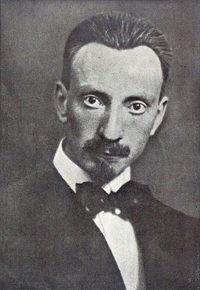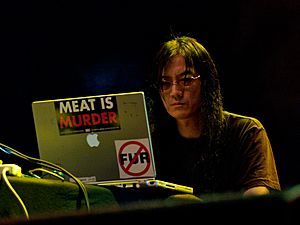Noise music facts for kids
Quick facts for kids Noise music |
|
|---|---|
| Stylistic origins |
|
| Cultural origins | 1910s, Italy |
| Derivative forms |
|
| Subgenres | |
|
|
| Fusion genres | |
|
|
| Regional scenes | |
|
|
| Other topics | |
|
|
Noise music is a type of music that uses noise as its main sound. It challenges the idea of what sounds are "musical" and what are "non-musical." This music can include many different styles and creative ways of using sound.
Noise music can be made with sounds from acoustic (natural) or electronic sources. It uses both regular and unusual musical instruments. Artists might use sounds from machines, special vocal techniques, or recorded sounds. They also use field recordings, computer-made noise, and random electronic signals. These signals can include distortion, feedback, static, hiss, and hum. Sometimes, noise music is played very loudly and can be long, continuous pieces. It often involves improvisation (making it up as you go) and can sound like a cacophony (a harsh mix of sounds). Often, noise music does not use traditional melody, harmony, or rhythm.
The Futurist art movement, especially Luigi Russolo in the 1910s, was very important for noise music. Russolo wrote a famous paper called The Art of Noises. He also built special noise-making machines called intonarumori. The Dada art movement also played a role. Later, in the 1920s, French composer Edgard Varèse thought of music as "sound-masses." He believed that "anything new in music has always been called noise." He asked, "what is music but organized noises?"
In 1948, Pierre Schaeffer created musique concrète (concrete music). His Cinq études de bruits (Five Noise Studies) used recorded sounds. One piece, Etude aux Chemins de Fer (Railway Study), was made entirely from train station noises. This showed that non-musical sounds could be used to make music.
In the 1960s, the Fluxus art movement also explored noise. Artists like Yoko Ono and Nam June Paik were part of this.
Today, noise music is often known for being very loud and using a lot of distortion. Famous types include noise rock, no wave, industrial music, and Japanoise. Bands like Lou Reed's Metal Machine Music and Sonic Youth are well-known examples. Other artists like Iannis Xenakis and Merzbow also use noise in their work.
Contents
What is Noise?
It can be hard to define noise in music. Here are some ways people think about it:
- Noise can be an unwanted sound, like noise pollution.
- In electronics, noise can be an unwanted signal. Think of the "snow" on an old TV screen.
- Noise can be data without meaning, just a side effect of other activities.
- It can block or change a message in communication.
What is considered "noise" has changed over time. For example, Ludwig van Beethoven's Grosse Fuge (1825) sounded like noise to people back then. His publishers even made him remove it from its original piece.
John Cage's famous piece 4'33" (1952) is a key example of noise music. In this piece, a performer sits silently for four minutes and thirty-three seconds. The "music" is made up of all the accidental sounds the audience hears during that time. Cage believed there is no true silence, and all sounds can be used creatively.
How Noise Music is Made
Noise music takes sounds that might seem negative and uses them in creative ways.
- Some artists use old audio technology like wire-recorders or 8-track cartridges.
- Many artists build their own devices to make noise.
- They might even create their own special recording equipment or computer programs.
Early Noise Music (1910s–1960s)
The Start of Noise Music
In 1910, French composer Carol-Bérard wrote a Symphony of Mechanical Forces. He also worked on how to use noise in music.

In 1913, Futurist artist Luigi Russolo wrote his paper, The Art of Noises. He said that the Industrial Revolution made people ready for more complex sounds. Russolo felt traditional music was too limiting. He saw noise music as the future. He built noise-making machines called intonarumori. He even put together a noise orchestra to play them. His works like Awakening of a City were first played in 1914.
A concert of his Gran Concerto Futuristico (1917) caused strong reactions from the audience. None of Russolo's original machines still exist. However, some have been rebuilt and used in new performances. Russolo's work helped to make noise an accepted part of music. It also changed how people saw sound as an art form.
At first the art of music sought purity, limpidity and sweetness of sound. Then different sounds were amalgamated, care being taken, however, to caress the ear with gentle harmonies. Today music, as it becomes continually more complicated, strives to amalgamate the most dissonant, strange and harsh sounds. In this way we come ever closer to noise-sound.
Antonio Russolo, Luigi's brother, made a recording in 1921. It featured the original intonarumori mixed with regular orchestra music. This is the only surviving recording of these early noise machines.
Using Found Sounds
Around the same time, artists started using everyday sounds as music.
- In 1917, the show Parade in Paris used sounds like a dynamo, Morse code machine, and typewriters.
- In 1922, Arseny Avraamov's Symphony of Factory Sirens used navy ship sirens, car horns, and even cannons.
- Arthur Honegger's Pacific 231 (1923) copied the sound of a steam locomotive.
- Ottorino Respighi's Pines of Rome (1924) included a recording of a nightingale.
- George Antheil's Ballet Mécanique (1924) used 16 pianos, 3 airplane propellers, and 7 electric bells.
In 1931, Edgard Varèse's Ionisation used 37 percussion instruments. It also included 2 sirens and a lion's roar. This piece was one of the first to be based only on noise. John Cage said Varèse "moved into the field of sound itself."
In 1937, John Cage said he was interested in using "extra-musical materials." He saw no difference between "noise" (like rain or static) and "musical sounds." He believed all sounds could be used creatively. In 1939, he started making works like Imaginary Landscape #1. This piece used two record players with special frequency recordings.
Experimental Music
I believe that the use of noise to make music will continue and increase until we reach a music produced through the aid of electrical instruments which will make available for musical purposes any and all sounds that can be heard.
In the late 1940s, John Cage and Lou Harrison started making music with "junk" percussion. They found things like brake drums and flower pots in junkyards.
In Europe, Pierre Schaeffer created musique concrète. This music used recorded sounds, electronics, and tape. He would manipulate these sounds. His Cinq études de bruits (1948) used transformed locomotive sounds and sounds from saucepans.
Other composers like Karlheinz Stockhausen and Iannis Xenakis also made important electronic and instrumental works using found sounds. In 1947, Antonin Artaud recorded To Have Done with the Judgment of God. This piece was full of random sounds, screams, and grunts. In 1949, Yves Klein wrote The Monotone Symphony. It was a 40-minute piece with a single, long sustained chord.
In 1951, John Cage's Imaginary Landscape #4 used twelve radio receivers. The sounds were chosen by chance operations. In 1952, Cage created Williams Mix using 600 tape fragments. That same year, he presented 4'33", his famous "silent piece." The audience heard only the sounds around them. Cage wanted to show that noise is always happening and can be musical.
In 1957, Edgard Varèse made Poème électronique. It used noises created by scraping, thumping, and blowing. In 1960, John Cage made Cartridge Music. It used record player cartridges with strange objects instead of needles.
Canada's Nihilist Spasm Band formed in 1965. They are the world's longest-running noise act. They still perform and record today.
Popular Music and Noise
Freak Out! (1966) by the Mothers of Invention used avant-garde sound collage. The band the Velvet Underground also made a track called "Noise" in 1966.
"Tomorrow Never Knows" by the Beatles (1966) used looped tape effects. Paul McCartney made these loops after listening to Karlheinz Stockhausen's music. The Beatles continued this with "Revolution 9" (1968), which was made only of sound collage.
In 1975, Ned Lagin released Seastones. This electronic noise music album had spacey sounds and bleeps. It featured members of the Grateful Dead and Jefferson Airplane.
Noise Music Today (1970s–Present)
Noise Rock and No Wave
Lou Reed's album Metal Machine Music (1975) is seen as a very early example of noise music. Some people called it the "greatest album ever made," while others called it one of the "worst." Reed was influenced by La Monte Young's drone music. Young's group, Theatre of Eternal Music, used loud, sustained notes in the 1960s.
Krautrock bands like Neu! and Faust also used noise in their music.
Noise rock mixes rock with noise. It uses rock instruments but with lots of distortion and electronic effects. It often has atonality (no clear musical key) and improvisation. Sonic Youth is a famous noise rock band. They were inspired by No Wave composers like Glenn Branca. Early No Wave bands like Mars and DNA mixed punk rock with avant-garde music.
Industrial Music
In the 1970s, industrial music appeared. Bands like Throbbing Gristle and Cabaret Voltaire made noise music. They often used strange tape editing, harsh percussion, and repeated loops. These sounds were distorted until they became harsh noise.
Industrial noise groups like Killing Joke and Einstürzende Neubauten used loud metal percussion, guitars, and unusual "instruments." These could include jackhammers and bones. They often had complex stage performances. Artists like John Duncan also used shortwave radio in their music.
The rise of affordable home cassette recording in the 1970s helped the No Wave style grow. This led to what we now call noise music.
Japanese Noise Music (Japanoise)
Since the early 1980s, Japan has produced many harsh noise artists. This style is sometimes called Japanoise. Merzbow (whose real name is Masami Akita) is perhaps the best-known Japanoise artist. He was inspired by Dada artist Kurt Schwitters. Akita took Metal Machine Music as a starting point. He made noise even more abstract by freeing it from just guitar feedback.
Other important Japanese noise artists include Hijokaidan, Boredoms, C.C.C.C., and Incapacitants. Many people believe that noise music truly became a genre with the huge growth of Japanese noise music, especially from the 1990s onwards.
Post-Digital Music
After industrial noise, noise rock, and Japanoise, many new noise musicians appeared. Their music is often more subtle. It can be ambient, microsound, or glitch-based. This is sometimes called a postdigital movement. It uses sounds that come from "failures" in digital systems. Some of this music has become widely available through peer-to-peer file sharing and free online music labels.
|
 In Spanish: Noise para niños
In Spanish: Noise para niños
- Chiptune
- Circuit bending
- Colors of noise
- Dark ambient
- Death growl
- List of noise musicians
- List of Japanoise artists
- Lo-fi music
- Noise in music
- Post-punk
- Phonation
- Screaming (music)
- Sonic artifact


